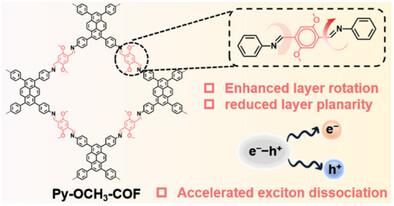Reducing Exciton Binding Energy in 2D Covalent Organic Frameworks by Decreasing Layer Planarity
IF 19
1区 材料科学
Q1 CHEMISTRY, MULTIDISCIPLINARY
引用次数: 0
Abstract
2D covalent organic frameworks (2D COFs) exhibit pronounced excitonic effects, which severely limit the yield of free charge carriers and photocatalysis performance. While attempts to mitigate this limitation are scarce, and convincing relationship between molecular structure and excitonic effects remains unclear. A straightforward design principle is presented for optimizing excitonic effects by reducing layer planarity, using pyrene-derived COFs as exemplary cases. Three pyrene-derived COFs are constructed from 4,4′,4″,4‴-(pyrene-1,3,6,8-tetrayl) tetraaniline (PyTTA) and terephthalaldehyde building blocks incorporating additional functional groups (─OH, ─H, and ─OCH3). Compared to the parent case (Py-H-COF), the ─OH groups introduce a layer locking effect through the presence of hydrogen bonds, whereas the ─OCH3 substituents facilitate local rotation out of the layer due to their large steric hindrance. Decreased layer planarity upon going from Py-OH-COF to Py-H-COF and to Py-OCH3-COF hampers local conjugation and, as shown by experimental and theoretical results, is accompanied by a marked decrease in exciton binding energy. This distortion, in turn, accelerates exciton dissociation and suppresses free carrier recombination. Accordingly, Py- OCH3-COF, the case with the lowest exciton binding energy (43.2 meV), demonstrates superior photocatalytic degradation of organic pollutants. These findings provide valuable insights for improved design of 2D COFs as high-performance photocatalysts.

通过降低层平面度降低二维共价有机框架中的激子结合能
二维共价有机框架(2D COFs)具有明显的激子效应,严重限制了自由载流子的产率和光催化性能。尽管试图减轻这一限制的努力很少,但分子结构和激子效应之间令人信服的关系仍不清楚。以芘衍生COFs为例,提出了通过降低层平面度来优化激子效应的简单设计原则。三个芘衍生的COFs由4,4′,4″,4′-(芘-1,3,6,8-四基)四苯胺(PyTTA)和对苯二醛组成,并含有额外的官能团(─OH,─H和─OCH3)。与双亲(Py-H-COF)相比,─OH基团通过氢键的存在引入了层锁定效应,而─OCH3取代基由于其大的空间位阻而促进了层的局部旋转。从Py-OH-COF到Py-H-COF和Py-OCH3-COF,层平面度降低阻碍了局部共轭,实验和理论结果表明,激子结合能明显降低。这种扭曲反过来加速激子解离并抑制自由载流子重组。因此,激子结合能最低(43.2 meV)的Py- OCH3-COF对有机污染物具有较好的光催化降解效果。这些发现为改进二维COFs作为高性能光催化剂的设计提供了有价值的见解。
本文章由计算机程序翻译,如有差异,请以英文原文为准。
求助全文
约1分钟内获得全文
求助全文
来源期刊

Advanced Functional Materials
工程技术-材料科学:综合
CiteScore
29.50
自引率
4.20%
发文量
2086
审稿时长
2.1 months
期刊介绍:
Firmly established as a top-tier materials science journal, Advanced Functional Materials reports breakthrough research in all aspects of materials science, including nanotechnology, chemistry, physics, and biology every week.
Advanced Functional Materials is known for its rapid and fair peer review, quality content, and high impact, making it the first choice of the international materials science community.
 求助内容:
求助内容: 应助结果提醒方式:
应助结果提醒方式:


